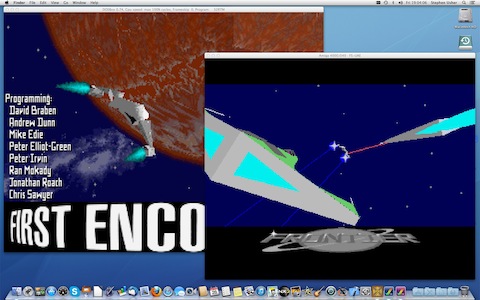I wonder if we all use slightly different naming nomenclature for the Elite series?
Maybe different countries had a different name for the games etc?
In the UK i understand that the series is in this order:
1. Elite (the 8bit home computer era), 1984. The first Elite with airplane combat.
2. Elite Plus (PC DOS version), 1991. A PC update of the first game.
3. Frontier: Elite II (the 16bit home computer era), 1993. A complete new game, Newtonian physics etc.
4. Frontier First Encounters (PC DOS), 1995. Furthering much of what Frontier had done, new storylines, slightly better graphics etc. LOTS of bugs on initial release, but now very awesome

Although the last game could be called Elite III, unlike Frontier it didn't feature that on the box or in the game. I think many people were put off from FFE due to the state of it's buggy release, which is a shame because having played them all down the years, it really is the best version to date (with most of the bugs now fixed).
I can absolutely say, with hand on heart, that in FFE you will now get multi-craft combat, that is get into dogfights where more than one enemy will be able to hit you (and you hit them) all at the same time.
And it is not easy, you will die a lot at first, until you get better at combat or get a better ship/equipment. But this has always been the way of Elite, see my closing 'On death' statement.
And that is in a Newtonian physics model game, so no 'airplanes in space' combat (which wasn't bad, just not that realistic). This didn't really happen in Frontier for the most part, so combat mostly became a form of space joust with one opponent at a time.
=============================
Going back to your excellent article Drew, one thing that doesn't help either of the later games, in terms of immersion, and perhaps that can be a source of your 'not fun', is the Stardreamer speed-up-time aspect. And here is why.
The Stardreamer is kind of awesome. You can watch a solar system rotate, view sun rises and sun sets across any planetary body, space station or city.
With it you can live long enough (in your real life!) to survive the actual travel times of near real inter-planetary travel when in system. The game had to come up with something to offset this problem!
However. What tends to happen, especially for new players, is they simply whack the Stardreamer onto maximum speed, all the time. Everything passes in a blur, you miss all the awesome detail the game can render in it's awesome Newtonian near-real space model.
So for the most part both Frontier and FFE become games where you have static in dock situations, where you choose cargo, upgrade your ship, chat to people on the bulletin board etc.
Then on taking off towards your new destination, you have a few minutes to appreciate the game model as you fly to your jump point destination, Jump, then on entering a new system stick the Stardreamer on MAX and 'bing' you are docked again, somewhere (if not dead after the infamous crash-you-into-object bug!). Back to the bulletin board etc. Rinse and repeat.
I certainly found the Stardreamer, if not used and controlled well by myself, added a sort of massive disconnect to the game world for me, much of my game time, maybe 50%, is spent in that blur of max speed Stradreamer mode. And that did leave you feeling less immersed in the world in general.
The trick (and what the Stardreamer should have able to simulate in game as a setting imho) to using the Stardreamer is to use the speed settings progressively. There are 5 speed settings(5 max, 1 low(real time)). I will use approximate AU settings to explain:
Once you are in a new system, say with 12AU to go, set the Stardreamer speed to Max(5).
At 4AU set it to (4).
At 1AU set it to (3).
Between 1AU and less, jump between the (3) and (2) speed setting. What you are aiming for is a smooth gradual approach to your target (a world/space station). You want to experience it gradually getting closer, not whizzing by in a blur and arriving abruptly at dock.
This adds massively to the game immersion, and removes a large part of the 'un-fun' that is due to the disconnect the Stardreamer can introduce to the game flow. It makes the universe seem more real and connected, it really should have been a setting in the options, as running this routine manually each time might be too much for many gamers.
But yes i agree with you that in many ways both Frontier and FFE missed their target of 'perfect' due to various reasons. Overall on balance though, their ambition, as you mentioned, is what really mattered. I'm really hoping that David and FD maintain that drive for ambition in Elite: Dangerous, it sounds like they will be going from what we can find out here on the forums
 On death
On death. Death was pretty abrupt in Elite also, maybe you have forgotten the process of getting your wings when you first got the game? I know i died as much as a new Elite player as i did a new Frontier and FFE player. Space IS dangerous, and that has always been part of the charm and attraction of all the Elite games, they never patronize you as a person by shielding you from that danger (as most modern games do now as rote). Long may that tradition continue.


